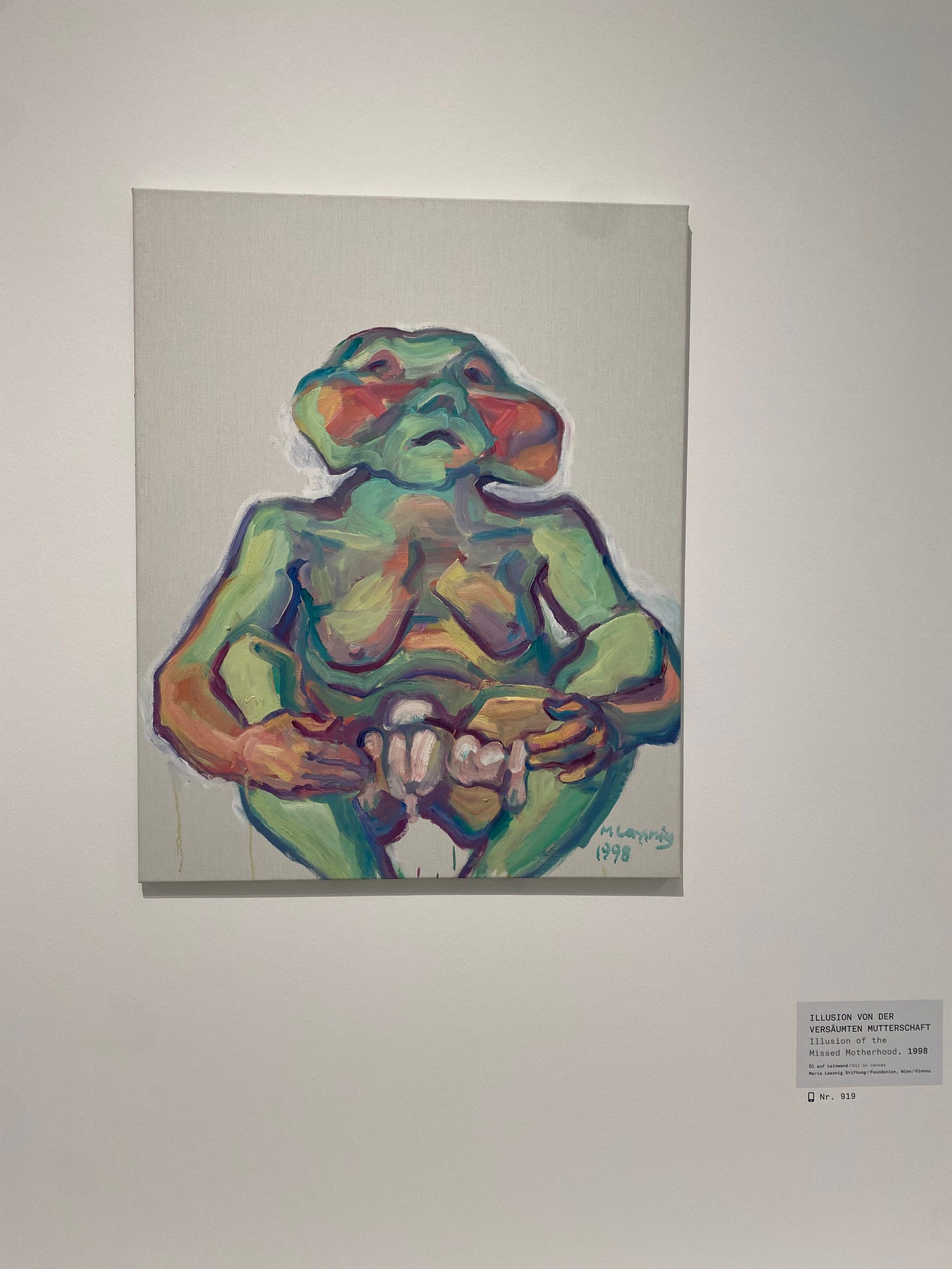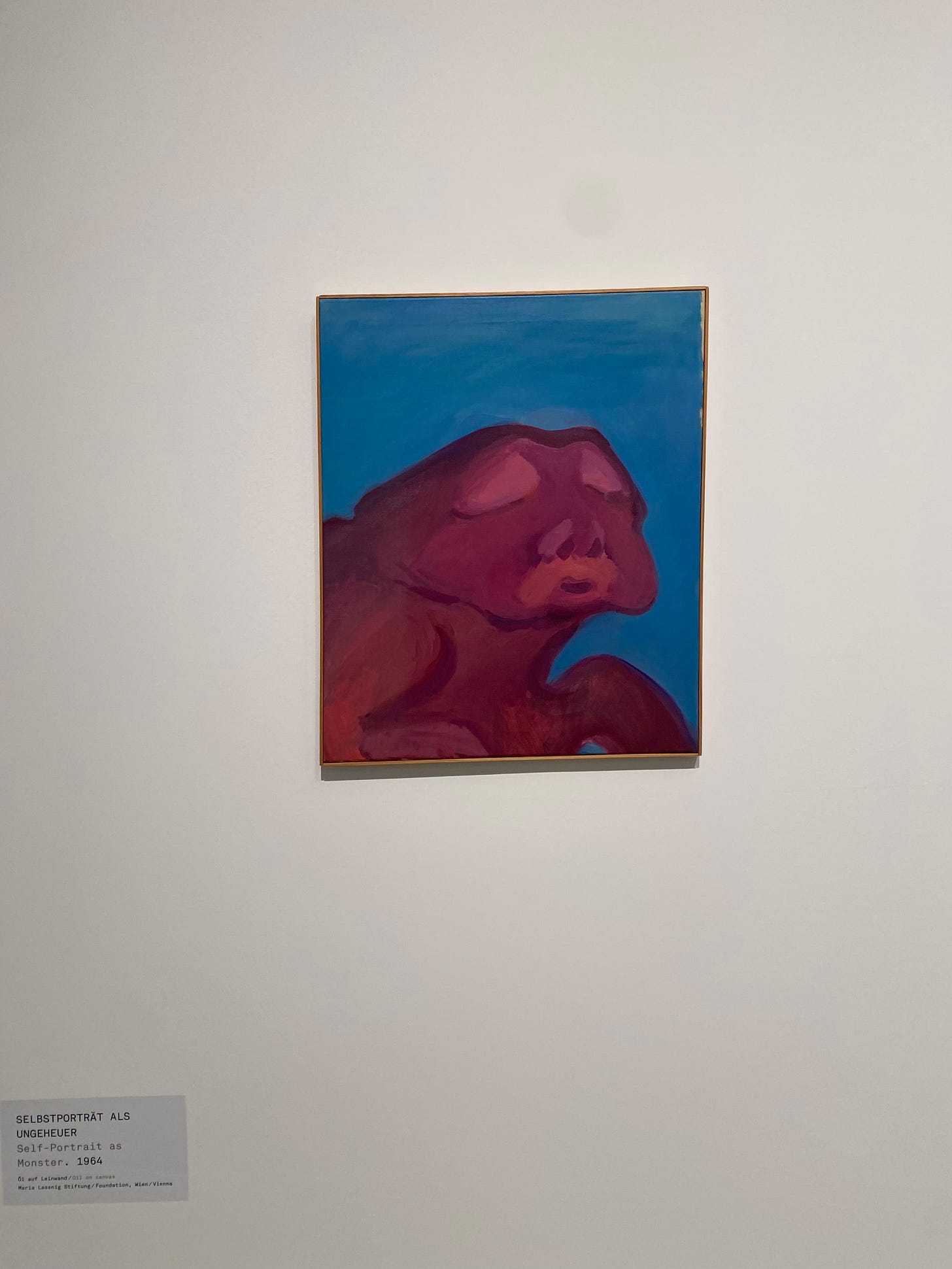The exhibition at the Kunsthalle Mannheim shows three underestimated female artists who explored the body from different viewpoints, starting their journey in the early 20th century. They explored surrealism and developed their artistic language focusing on a timeless theme: the female perception of the body.

Nan Hoover - Secrets in the Bedrooms
Nan Hoover's (1931-2008) works include dark charcoal drawings, bright paintings, videos, and photographs that show the interplay between her body and the surrounding light. The American artist moved to Amsterdam in the 1970s and focused on video art, performance, and photography, which she presented in her solo exhibition at the Stedelijk Museum, Amsterdam, in 1979.1 By using her body in light and shadow, Hoover slowly began to develop her artistic vocabulary towards minimalism.
Some colorful paintings have never been shown before. One shows a man in an orange shirt holding two tiny figures in a black hand, like a skeleton hand. A small woman with orange hair sits on a man's lap. This is an absolutely strange scene. Other paintings show naked people of different skin colors interacting with their bodies or their surroundings – a man pressing his hands against a wall to escape or just to explore his surroundings.
Some works are more sexualized. In one painting, a man is licking through a hole. Hoover shows different body types, sexualities, including homosexuality, and the dynamic between individual and societal perception. However, it is important to note that Hoover's works are neither pornographic nor erotic; rather, they openly show the human body and the hidden inner life or intimate moments that take place in private spaces.
Anneliese Hager - The Light Behind the Shadow
Anneliese Hager (1904-1997) is more unknown, but her artworks are absolutely underrated. She worked with photograms like other well-known artists such as Lászlo Moholy-Nagy or Man Ray. Photograms are photos created without a camera. In the 1920s, she worked as a photographer and as a technical assistant for photomicrography in Berlin. Her first experiments with photograms began in 1935. She wrote about her first attempts:
„Pine needles and mate tea leaves were the first objects I placed on the photographic paper under red light. Gradually they became more complicated in their execution. Forms were cut out of paper, plastic or cellophane, shards of glass were added. Leaves in all their various natural forms, fibers, wool fibers, hanging spun threads, thin fabric, burlap.“
Exhibition wall text, Kunsthalle Mannheim

She also wrote surrealistic prose poetry, such as "Die rote Uhr" from 1947. Her husband, Karl Otto Götz – a famous German artist associated with Art Informel – created the lithographs for the book, which was published in 1963.2 She wrote:
Ich war …
Ich war ein Baum
und tauchte meine Blätter
in das Gespinst der grauen Wolke
und öffnete in ihrem Schatten
die Rinde die sich füllen sollte.
[…]3
Her words are poetic, figurative, and have surreal moments. Hager dealt with surrealism – recognizable things from reality that are modified into a new reality – in her photograms and also her poems.
Maria Lassnig - The bright side of life?
Works by Maria Lassnig (1919-2014) can be seen in the last rooms: Animated films and colorful paintings. She focuses on the human body, especially her self-image in a male-dominated art world.
Large brushstrokes and pastel shades blend into one another, resembling a colorful bouquet of flowers. The colors cascade down the surface. Yet, what are Lassnig’s motifs? It becomes evident that there isn't much going on, but the colors, combined with the surface and the strange creatures, evoke strong emotions. Lassnig directs your gaze at the human being or the thing – the monstrous thing – upon which she fixates. It is large, it is vibrant, and it raises questions… Her painting "Illusion of Missed Motherhood" from 1998 portrays a human figure with a white, fluffy aura, giving birth to a small entity.
This brings to mind Barbara Creed's theory of the "Monstrous-Feminine"4, focusing on horror films depicting women as monsters, as seen in "Carrie," "The Exorcist," or the Netflix movie "Mother" starring Jennifer Lawrence. In essence, women's sexuality, including their ability to give birth, is perceived as frightening and is rejected in patriarchal systems. Films like those mentioned portray the woman as the embodiment of evil, disguised as a monster. Lassnig does something similar, albeit without masking women behind monster costumes; she reveals how women feel in a male-dominated society: monstrous, as society perceives them.
These emotions, deeply ingrained in Lassnig, find expression in what she terms "Körperbewusstseinsbilder"5 (Body Consciousness Images). It's not the body as a physical object that she wishes to highlight, but rather the sensations of the body6:
„Ich male und zeichne nicht den ›Gegenstand‹ Körper,
sondern ich male Empfindungen vom Körper“
Maria Lassnig
Paintings that evoke a sense of strangeness and deep emotion are the work of a remarkable artist who deserves even greater recognition.
Last words…
The exhibition concept of the Kunsthalle Mannheim is special: the show is divided into three parts. Each female artist has her solo show with a separate catalog. The main drawback is that the artists cannot enter into a dialogue; they stand alone and are not connected. The explanation by curator Inge Herold seems somewhat simplistic to me: It's about the encounter with surrealism, but also their exploration of physicality, she said.7
The question arises: What is the purpose of this exhibition? Is it to provide a platform for underrated female artists or to connect them and promote a dialogue between them? In my opinion, the concept works, but only because there is a strict separation in the exhibition plan. Overall, the exhibition highlights each individual female artist. Thankfully, they are finally receiving the attention they deserve.
Kunsthalle Mannheim
Friedrichsplatz 4
68165 Mannheim, Germany
HOOVER HAGER LASSNIG
10.11.2023 – 28.04.2024
More about Nan Hoover’s biography: http://www.nan-hoover.com/8_vita/solo_exhibitions.htm (27.01.23).
Vgl. K. O. Götz, Cover Publikation „Die rote Uhr“ 1963, URL: https://ko-goetz.de/druckgraphik/cover-publikation-die-rote-uhr-1962/, (27.01.23).
lyrik online, Anneliese Hager: Ich war…, URL: https://www.lyrik.ch/lyrik/spur4/hager/hager.htm#tag, (27.01.23).
Vgl. Barbara Creed: The Monstrous-Feminine. Film, feminism, psychoanalysis, New York 1994.
Katy Hessel: The Story of Art without Men. Große Künstlerinnen und ihre Werke, München 2022, S. 351.
Käthe Kollwitz Museum Köln: Maria Lassnig. Die Sammlung Klewan, ULR: https://www.kollwitz.de/maria-lassnig#:~:text=1968 zieht es sie nach,Malerei und Trickfilm in Wien., (27.01.23).
o. A., Ausstellung in der Kunsthalle Mannheim „Hoover, Hager, Lassnig“ in Mannheim: Künstlerinnen des Körperlichen, in: SWR2, 08.11.23, URL: https://www.swr.de/swr2/kunst-und-ausstellung/hoover-hager-lassnig-ausstellung-in-mannheim-drei-kuenstlerinnen-mit-vielen-schnittmengen-100.html, (27.01.23).









Wow, I really like Lassnig's work, especially Illusion of the Missed Motherhood. I've never given birth before, but I can imagine one can feel quite monstrous and insecure in their body with all the strange changes happening, and the way society acts like these very natural changes are so disgusting and inconceivable. At the same time, though, society tells women it is their purpose to reproduce and they should feel proud to do so -- that they're doing well by the human race. Very mixed messaging, which I think is perfectly represented by the image of a monstrous figure having an almost angelic aura. She's virtuous for giving men what they want, but monstrous for the transformation she must undergo to do so. Thanks for the introduction.